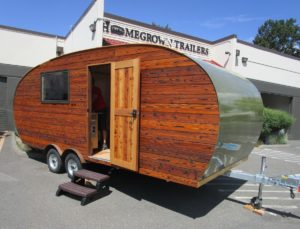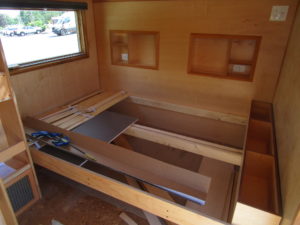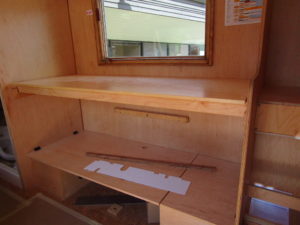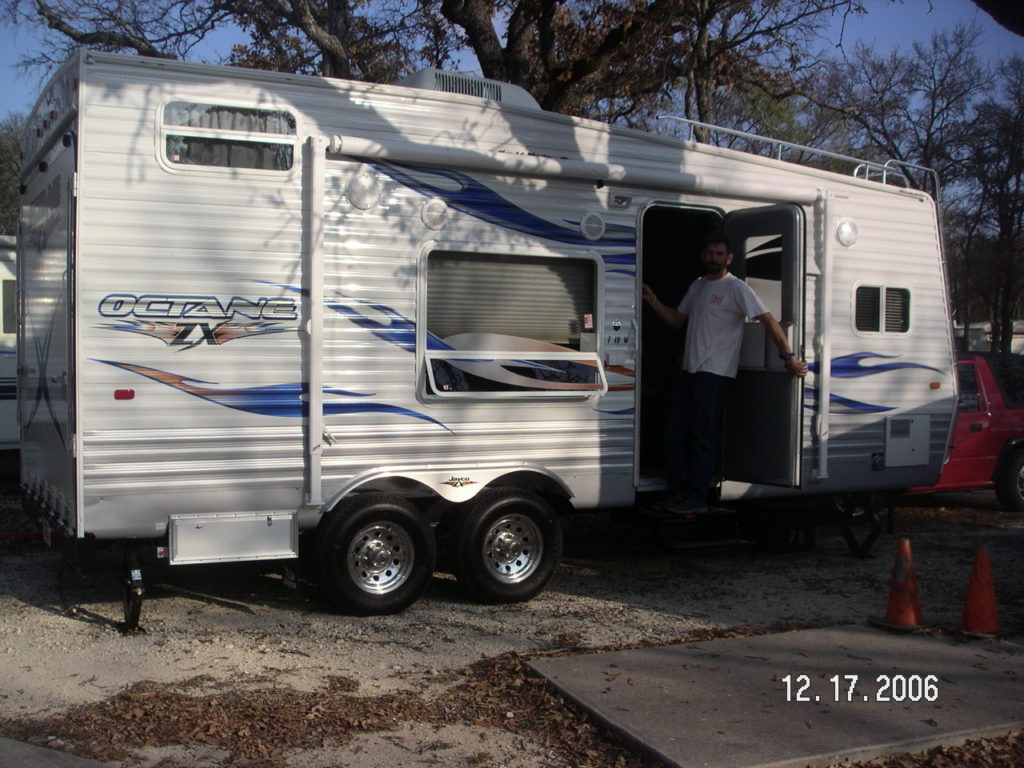Early in the project brainstorm process, we debated a major question: Do we renovate our 2007 Jayco Octane travel trailer, or do we start over with a new trailer (or RV) that might have a lot of what we want already built in?
We were looking for something that is powered completely with electricity (for all living space functions), has a larger solar system than our current version, and has more (and lithium) batteries. It needs to allow us to boondock like we are accustomed to. That means living off-grid indefinitely as long as we have some sunshine, limited only by extended bad weather and water refills/sewer dumps. Making note that we tend to choose excellent weather in the first place, not usually attempting winter camping or crazy long/hot summers.
And we need (OK, need is a strong word – WANT) to be able to continue living the nomadic “on the road” life.
The list of considerations includes:
- Availability (now or how soon?)
- Timeline for having a completely all-electric living space
- Amount of solar we could put on the roof
- Cost
- Weight, which will affect the range of an electric propulsion system
- Aerodynamics, which affects drag and therefore the driving range
- Living space and the ability to carry our stuff and sit at a table
- Is it driveable? (i.e. is it an electric RV or does it need to be towed with the electric truck we don’t have yet?) And if so, what is the range?
- Potential sponsorship opportunities with a company partner (maybe?)
While researching various options, I came up with the following list. I’m sure it will be out of date soon after it’s published, in fact it might already be old news. I don’t intend to keep the list current, but if you know of updates or others to include, please send us a note and I’ll make an edit.
(And if you just want to skip to the decision we made, click here)
Homegrown Trailers
Homegrown builds all-electric trailers in Kirkland, WA. The idea that we could purchase a trailer that was already made to use electricity as the only power source, plus the fact that they are available now, put this one at the top of the list of potential new purchases.
I first heard of them from the RV Entrepreneur podcast when Heath talked with Eric Gertsman, a Homegrown cofounder. Good information if you’re looking for more info on the company.
Our summer tour was already taking us to Oregon in June 2019, so we decided to venture one more state north to visit their factory. At the time I was particularly pro “buy new” if we could find a drop-in solution. The people working there were super helpful, willing to show us around, happy to answer a barrage of questions in person, and also communicated easily via email.

We focused on their Timberline model. It’s 23 feet long and has options for off-grid upgrades. Our preference was the Extended Off-Grid version that included 800W of solar, 6 kWh lithium batteries, 2000W inverter/charger, and high-efficiency 12V fridge/freezer.
The solar panels are flexible because the roof is curved, which is pretty interesting except there may be some loss of efficiency because the panels are never facing completely toward the sun. Still, points for creativity and also for making us think about flexible panels for other uses.
Most of the trailer is made of wood – quite pretty, easy to customize, and also a nice focus on using healthy/ sustainable materials.

We liked the simple design and the airy space with large windows and multiple fans.
Other details that we liked: Induction cooktop, composting toilet, super efficient water heater, large kitchen, and the ability to customize the bed and dinette configuration.
Regarding our list of considerations:
- Availability: Homegrown is building and taking orders for trailers now, although they said they are starting to focus more on fleet vehicles and trailers that will be placed in parks as rental units.
- Timeline for having a completely all-electric living space: Looks like a complete solution, as far as we can tell without actually living in one and testing the functionality.
- Amount of solar: 800 Watts (and an option for 180W more)
- Cost: As of June 2019, including all the options we were considering, the total could be around $69,000.
- Weight: Spec’d at 4,150 – 4,350 lbs dry weight
- Aerodynamics: Rounded roof, 8′ 11″ height, intuitively looks good

- Living space and the ability to carry our stuff: Nice living space – check. Ability to carry our stuff – here’s the biggest challenge for us. We live full-time on the road. We have downsized a LOT since we had a house in Austin, but we still have bikes, running stuff, camping gear, paddles/PFDs, winter clothes, even a set of cross-country skis. Well, the skis don’t have to come with us. But most of the rest of the gear wouldn’t fit into a Homegrown Trailer.
- Is it driveable? No, needs a tow vehicle.
- Potential sponsorship opportunities with a company partner: We didn’t approach them with this question, but I believe they would have at least entertained the idea, based on the vibe and personable feel.
There are a lot of pluses here. If we were looking for something for weekend trips, Homegrown would be at the top of our list. However, the combination of “where would our stuff go?” plus the price tag made us pause and reconsider what other options we had.
Tesla Model X plus small trailer
The other side of the equation is the tow vehicle. Right this moment there aren’t any electric trucks for sale. As far as I can tell, the only available EV that is rated for towing is the Tesla Model X. And it is rated at only 5000 pounds (although Tesla has demonstrated that it is capable of pulling much more, including a Qantas airplane and a semi truck on an icy road – more than once).
Probably best to keep it under 5000 pounds so you don’t void the warranty.
I found a couple stories about people using their Model X to tow a small trailer, and their experiences were helpful in describing things we will need to think about ourselves. Range vs. speed, weight, and headwind are great things to test. One big question will be how to access charging stations while towing a trailer. Good stuff for future reference.
For anyone interested in reading more, there is a summary thread on the Tesla Motors Club forum and here are the individual links:
Jack Bowers towed a Bowlus Road Chief trailer. Jim Vandegriff did something similar with an Airstream Bambi Sport. And Rolf and Silke (plus Kye the dog) pulled a Safari Condo Camping Trailer across Canada – and then across the United States as well. Most impressive.
So it is possible. I haven’t found mention of anyone doing this while living on the road full-time, but this is a great start.
As far as our list:
- Availability: Now, including used Model X’s and small trailers
- Timeline for having a completely all-electric living space: Unless we bought a Homegrown Trailer (see above, and there’s very little room for adding more weight to it and still remaining under 5000 pounds), any other small trailer would likely require quite a bit of work to convert to all-electric.
- Amount of solar we could put on the roof: Depending on the trailer, perhaps 800W
- Cost: I’ve seen used Model X cars (including the tow package) in the range of $70-90,000, with the advantage of great resale value when an electric truck is eventually available. Small used trailers should be way cheaper than a new Homegrown, maybe $10-15,000? I didn’t look too hard, obviously.
- Weight: By necessity the trailer plus all our stuff would need to be < 5000 pounds
- Aerodynamics: A teardrop trailer might be a decent shape for this
- Living space and the ability to carry our stuff: Probably quite a challenge
- Is it driveable? Yes, as a combo car + trailer. Reported range from the above real-life examples is 110 to 175 miles depending on driving speed, conditions, etc.
- Potential sponsorship opportunities with a company partner: Just a guess … Tesla doesn’t need advertising along these lines, unless we could get Elon Musk’s attention on Twitter. And this would be only a temporary solution anyway.
I’m not gonna lie – I’m a huge Tesla fan and would love to own one even “temporarily” until an electric truck is available. And the chance to switch almost immediately (or at least, having a timeline within our control) to all-electric for propulsion plus living quarters is tempting. It makes me smile to think about it.
But really, it would require quite a bit of effort and money and downsizing/storage and limiting our options.
It is fun to think about though!
Rivian R1T electric truck
Speaking of tow vehicles, our #1 choice right now is the Rivian truck. We have a deposit down and we were lucky to be able to attend an unveiling event in Atlanta.

The truck can tow up to 11,000 pounds and has a non-towing range of ~400 miles. Availability might, hopefully, please let it be in 2020.
I’ll go into more detail about this in a future post.
Other innovations – RVs and trailers
The following possibilities are interesting, but they fail the first item on our list. Availability = not now, nor in the foreseeable future. Range, weight, aerodynamics, and amount of living space varies. Some have a decent amount of solar. Most will probably cost a whole lot. Some are driveable (RV-style) and therefore would be a decent all-in-one answer to the challenge.
In no particular order:
– Winnebago is working with Motiv on a class A EV RV. It is available as a commercial vehicle, not yet for personal use. The range is 85 to 125 miles. They have a demo vehicle which is a mobile surgical instrument lab that travels across Los Angeles.
Also note that the Winnebago Travato has a Pure3 Volta Power Systems option that eliminates the need for a gas generator for living power. Instead it has a giant 8700 Wh lithium battery that is recharged with either shore power or the secondary engine alternator. No propane – that’s something!
– Dethleffs in Germany has announced the E. Home and E. Home Coco. The E. Home is a class C Euro-style camper van that is covered in solar panels (100 mile range). Two interesting pieces of technology: 1) Phase change materials (latent heat accumulator plates) that absorb heat when it’s hot and then release the heat during cooler temperatures at night. 2) High-power capacitors (“Supercaps”) which “allow a faster recharge and delivery of the electrical energy in comparison to the usual batteries.” I would love to know more about both of those.
The E. Home Coco is a small trailer that is electric-powered with batteries and motors on the axles so it assists with the driving and can be pulled with a smaller vehicle. Even more cool, it can park itself! This I have to see. Maybe someday we will.
– The Iridium E Mobil in Germany is a small motorhome with a 108 kWh battery pack and a claimed range of 249 miles. Now we’re talking useable distance between charging.
– The Nissan e-NV200 camper is a converted campervan with pop-up roof. It seems like a decent short-range option (124 miles) but maybe not so much for mobile living. They are also working on a passenger van version, which is nice to see.
– The VW electric ID. Buzz microbus is another concept vehicle that isn’t for sale yet (production starting in 2022). Expected range is over 250 miles. Plus it’s adorable.
– Britz eVolve is a fully electric campervan that is available now in New Zealand, but only to rent (excuse me, “hire out”). The range is only 120 km (75 miles) but the islands are a more manageable size than, say, Australia. They are partnering with specific holiday parks for camping (with charging) and they provide sample itineraries. Looks like we need to start planning a trip to New Zealand!
Other innovations – tow vehicle
Range numbers on these do not account for towing.
– Tesla Cybertruck electric truck. As a “huge Tesla fan” (see above) you can guess that I’m excited about this possibility. They unveiled the Cybertruck on November 21, 2019 and we immediately put down a deposit. It looks… different! Kind of like a personal Mars Rover. Cool. The Tri-Motor option has excellent range (500+ miles) and tow capacity (14,000+ pounds). As far as actual availability, I’m not holding my breath, although I want to.
In the days since the launch, our friend Bob pointed us to an additional announcement about the Cyber RV, a fifth wheel towed by the Cybertruck – hey Elon, if you’re looking for someone to live in it to test it out, we’re available!
– Bollinger electric truck – currently taking deposits, 200 mile range, 7500 pound tow capacity. Looks like they are focusing on off-road ability and using it as a work truck. Certainly a truck to consider.
– Ford electric F150 truck – Maybe in 2021? Details TBA. Would love to see this happen.
– Atlis XT pickup – Up to 500 mile range, well that got my attention. Fifth wheel towing up to 35,000 pounds and bumper hitch towing up to 17,000 pounds. Jeepers, those are some good numbers. We’ll be keeping an eye on Atlis to see if (and when) they can deliver.
– Workhorse W-15 pickup – 200 mile range, 6000 pound tow capacity, uncertain availability. Sounds like they will be selling them commercially (e.g. utility companies) before making them available publicly. Update – it looks like the line is now owned by Lordstown Motors and the truck is named Endurance, so there is hope that an electric truck will eventually happen in this space.
– Audi eTron car, an EV with the ability to tow up to 4000 pounds. 204 mile range. Great to see more options similar to the Tesla Model X.
Howie renovation
Finally back to the original question!
It’s great to see all these big ideas and hopefully in the next several years there will be at least as many actual options that you can actually buy.
As far as a fully electric RV, that doesn’t appear to be something we can go out and get right now.
Regarding the “Model X plus small trailer” idea, as much as it’s neat to contemplate, there wouldn’t be enough space for full-time living and would only be a temporary solution.
So we decided to narrow it down to available trailers (that can be modified to remove propane/gas) and work toward purchasing an electric truck when one is eventually available. We are familiar and comfortable with the truck + trailer configuration, and while we’d entertain an electric RV instead, at this point we don’t see a good reason to switch.
Which leaves us with these 3:
- Homegrown Trailer
- Buy a small trailer and renovate it
- Renovate Howie, our current trailer
#2 potentially would allow us to tow it with a Tesla, but again, would likely be too small. So if we’re banking on an electric truck, we’re also banking on one that can tow Howie or something similar. Our trailer was at about 8300 pounds at last weighing, including all our stuff, although we’re working to reduce that.
Homegrown has a lot of advantages, but we’re back to the question of where to put everything inside it. Not to mention, anything new will still require time and effort to get it set up the way we want.
So… what would a Howie renovation look like? For starters, we KNOW our trailer. We’ve been making modifications to it for years now, making it our own. The day I said “hey, I don’t care about resale value, let’s do what we want” was when the freedom started. It’s always fun when one of us says, “what about this, or what about that?” and we start envisioning things to change to make the space more useable.
I have to say, we knew we liked the toy hauler idea immediately when we first saw it in 2006. But we had no idea just how great it would be for customization. Carpet? Who needs carpet? It rolls up and bam! It’s removable, with a real floor already underneath. Those dinette seats are really in the way. Detach them, find someone who wants them (that wasn’t hard), gone! Tie-downs for holding a roller chair while we travel, check. Room for gear boxes and shelves and sleeping bags, all out of the way. A solid back door to attach a custom bike rack to. Space to transport solar panels that don’t fit in the truck? Yep! Oops, now I’m getting ahead of my story.
Over the years and through all the modifications and personalization, I’ve gotten pretty attached to Howie. I really do miss it when we’re staying other places. Not just that it signifies the mobile lifestyle (although that is a big part of it), it’s also our home. It feels solid, dependable, flexible, creative, and it feels like us.
One big challenge is the age of the trailer. We need to honestly assess what might cause problems down the line. The roof was the biggest concern. Otherwise, as a toy hauler it’s pretty solid.
So we came back around to the question of renovating Howie. The more we talked about what it would take to remove the propane and convert to all-electric, the more obvious the decision became. After all that, yes, we are staying with our tried-and-true trailer.
Howie in Austin way back in 2006 not long after we bought it:
For completeness, here is the list of considerations as relates to Howie:
- Availability = NOW (at least for going all-electric for the living space)
- Timeline for having a completely all-electric living space = sooner actually than I expected, especially since we have had the good fortune to be in the right place at the right time a couple times recently, and once we got started we haven’t slowed down
- Amount of solar we could put on the roof = 1580 Watts for sure, maybe closer to 2000 W (yep, we have plenty of roof space now!)
- Cost = I think we’ve done most of the major Howie-related purchases at this point and we’re under $10,000 (i.e. much lower than any of the alternatives), so our budget is ready for an electric truck
- Weight = yep, this is the main challenge, and I’ll focus on this more in later posts
- Aerodynamics = oh yes, the other main challenge and something we are brainstorming about too
- Living space and the ability to carry our stuff = DONE
- Is it driveable? Nope, need that electric truck
- Potential sponsorship opportunities = not with the trailer (I don’t think Jayco would be all that interested, seeing as we have done many modifications to their original design), but we can look ahead to an electric truck company and see what might be possible
There are obviously more details and stories about what happened next, but I really need to save all of that for another post. Or another twenty posts. And get to bed.
Geez, this post went on WAY longer than I expected. If you’re still here, thanks Mom! 🙂




Hello Marcy and John,
Interesting write-up. I’ll need more time to check out all of the links.
So far, based on what I’ve read, I like the Rivian truck + Howie. If you’re going to invest in a new truck, it seems prudent to me to stick with your current trailer since it is familiar, fits all your stuff and has lots of space for solar and you can always customize it to your needs. There may be better trailer option in the future which would require less of a major investment than buying an electric RV.
I’m curious about the expected range of the Rivian + Howie option. Do you know what your range might be on the Rivian Truck + loaded Howie trailer? I would think that Rivian can provide you with an estimate if you don’t know. I’m sure it would depend on your average speed.
Happy New Year !
Marc
Hi Marc and thanks for your great comments!
We like the idea of Rivian + Howie too. Hopefully it will be a reality in the near future and we can really test it out, figure out what works and what needs work.
Rivian says that range while towing is likely ~50% less. So around 200 miles. Which will be dependant on aerodynamics (biggest factor) and weight (to a lesser degree). And for sure, driving habits and speed and all the things that affect range and gas mileage of ICE cars as well. We’re looking forward to finding out!
-Marcy